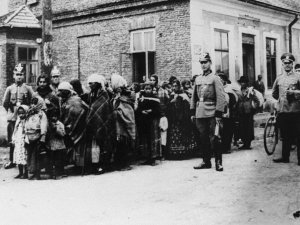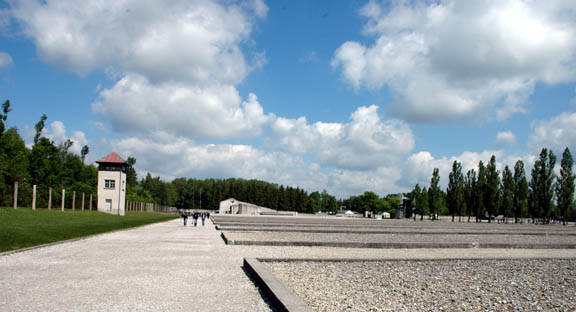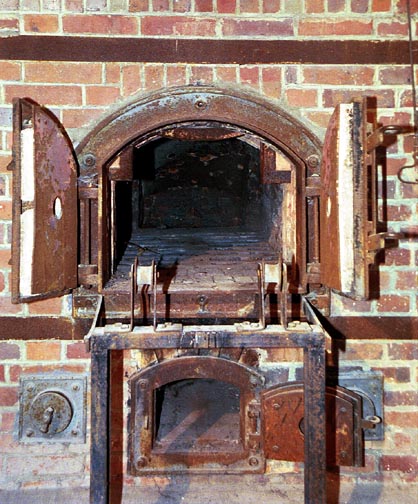Recently, my blog has been getting an inordinate number of hits from Norway. What could be going on in Norway? I set out to find out why hundreds of people in Norway have been reading my blog in recent days.
I did a search and found this news article: http://www.socialworkhelper.com/2015/08/04/black-hole-european-history-prevents-full-understanding-present/

Gypsies being marched out of Norway, to be taken to the gas chamber (click on photo to enlarge)
The following quote is from the news article, cited above:
A couple of days ago, we commemorated the liquidation 71 years ago of the so-called “Gypsy family camp” at Auschwitz-Birkenau. On 2 August 1944, 2 897 persons were taken to the gas chambers and exterminated. Only a few months earlier, on 16 May 1944, the detainees of the “Gypsy camp” had refused to obey the orders of the SS soldiers who had come to kill them. Knowledge about both the Roma uprising and the liquidation of the “Gypsy camp” remains limited in European societies today.
Oh no! The Gypsies had refused to obey the orders of the SS soldiers who had come to kill them! What did the SS soldiers say to the Gypsies? Maybe they said something like “lie down and die, you thieving scum” but the Gypsies refused. They insisted on being properly “exterminated” in a gas chamber.

A group of Gypsies waiting to be gassed at the Belzec extermination camp
For all the readers of my blog in Norway, here is what actually happened:
At Auschwitz-Birkenau, a “Gypsy family camp” was set up in wooden barracks in Section BIIe in the Birkenau camp in February 1943.
According to the US Holocaust Memorial Museum in Washington, DC, the Gypsy camp was in existence for only seventeen months and most of the Gypsies perished.
The following quote is from the web site of the USHMM:
In a decree dated December 16, 1942, Himmler ordered the deportation of Gypsies and part-Gypsies to Auschwitz-Birkenau. At least 23,000 Gypsies were brought there, the first group arriving from Germany in February 1943. Most of the Gypsies at Auschwitz-Birkenau came from Germany or territories annexed to the Reich including Bohemia and Moravia. Police also deported small numbers of Gypsies from Poland, Hungary, Yugoslavia, France, Belgium, the Netherlands, and Norway.
[The two states of Bohemia and Moravia, which are now in the Czech Republic, were part of a German Protectorate from 1938 to 1945; they were not annexed into the Greater German Reich.]
The following quote about the gassing of the Gypsies is from the web site of the USHMM:
They (the Gypsies) were killed by gassing or died from starvation, exhaustion from hard labor, and disease (including typhus, smallpox, and the rare, leprosy-like condition called Noma.) Others, including many children, died as the result of cruel medical experiments performed by Dr. Josef Mengele and other SS physicians. The Gypsy camp was liquidated on the night of August 2-3, 1944, when 2,897 Sinti and Roma men, women, and children were killed in the gas chamber. Some 1,400 surviving men and women were transferred to Buchenwald and Ravensbrück concentration camps for forced labor.
According to a guidebook sold by the Auschwitz Museum in 2005, there were 20,943 Roma (Gypsies) who were gassed in the Krema V gas chamber; their bodies were burned in the pits adjacent to Krema V.
Rudolf Hoess wrote in his autobiography, entitled Death Dealer, that many of the Gypsy children suffered from an illness called “Noma,” which reminded him of leprosy.

Gypsy children suffering from a disease called “Noma.”
According to Rudolf Hoess, Heinrich Himmler inspected the Gypsy camp on his visit in July 1942. Hoess wrote in his autobiography entitled Death Dealer:
Himmler inspected everything thoroughly. He saw the over-crowded barracks, the inadequate hygienic conditions, the overflowing infirmaries and the sick in the isolation ward. […] Himmler saw everything in detail, as it really was. Then he ordered me to gas them. Those who were still able to work were to be selected, just as with the Jews.
In his date book, Heinrich Himmler noted that, on his visit to Auschwitz in July 1942, he inspected the main camp, the farm at Auschwitz and the Monowitz factories, where photographs were taken of him. He did not mention that he visited Birkenau.
Danuta Czech wrote in her book entitled Kalendarium that 1,408 Gypsies who were able to work were transferred to the main Auschwitz camp and housed in Blocks 10 and 11 on May 23, 1944. They were later sent to the Buchenwald concentration camp, where there is a memorial sculpture in commemoration of the Roma.
The selection of the Gypsies for the gas chamber took two years, according to Commandant Rudolf Hoess. Regarding the liquidation of the Gypsy Family Camp on August 2, 1944, Hoess wrote the following:
By August 1944 there were only about four thousand Gypsies left and these had to go into the gas chambers. Until that time they did not know what fate was in store for them. Only as they were marched barrack after barrack to Crematory I did they figure out what was going on.
When Hoess wrote that the Gypsies were marched to Crematory 1, he was undoubtedly referring to Krema II, which was a short distance from the Gypsy camp. Crematory 1, or Krema I in German, was in the main Auschwitz camp, three kilometers from Birkenau. By August 1944, Krema I was no longer in operation as a gas chamber.
Both the USHMM and the Auschwitz Museum say that the number of Gypsies gassed on August 2, 1942 was 2,897, not “four thousand” as Hoess stated. However, according to the article below, the number of 4,000 given by Hoess might actually be closer to the correct number of Gypsies who were gassed.
Regarding the gassing of the Gypsies, Dr. Miklos Nyiszli wrote the following:
Annihilation time had come for the 4,500 inhabitants of the Gypsy Camp. The measures taken were the same as those taken for the liquidation of the Czech Camp. All the barracks were quarantined. SS guards, leading their police dogs, invaded the Gypsy quarters and chased the inhabitants outside, where they were made to line up. Rations of bread and salami were distributed. The gypsies were made to believe that they were being shipped to another camp, and they swallowed the story. A very easy and efficacious way of calming their fears. No one thought of the crematoriums, for then why would rations of food have been distributed?
This strategy on the part of the SS was dictated neither by pity nor a regard for those condemned to death, but merely by their desire to expedite a large group of people, without any unnecessary incidents or delays, to the gas chambers, guarded by a relatively small patrol. The strategy worked to perfection. Everything went off as planned. Throughout the night the chimneys of number one and two crematoriums sent flames roaring skyward, so that the entire camp was lighted with a sinister glow.
If Dr. Nyiszli’s story is correct, the method of calming the fears of the Gypsies amounted to a tremendous waste of bread and salami. Or was the “salami” actually what Americans call Thuringer, a type of smoked, semi-dry German sausage similar to our summer sausage? It is doubtful that the Nazis imported salami for the Auschwitz prisoners.
Note that Dr. Nyiszli, who worked in the “crematoriums” performing autopsies for Dr. Josef Mengele, referred to “number one and two crematoriums” but he obviously meant Krema II and Krema III at Birkenau, not Krema I, which was at the main camp.
The total number of Gypsies killed in the Holocaust is unknown. Numbers vary, from 220,00 estimated by the USHMM, to an estimated 500,000.
One of the three Operation Reinhard camps, Belzec was allegedly the first camp to begin the gassing of Jews and Gypsies in March 1942.

Gypsies were forced to work in the Dachau camp, but for some reason, they were not gassed at Dachau













